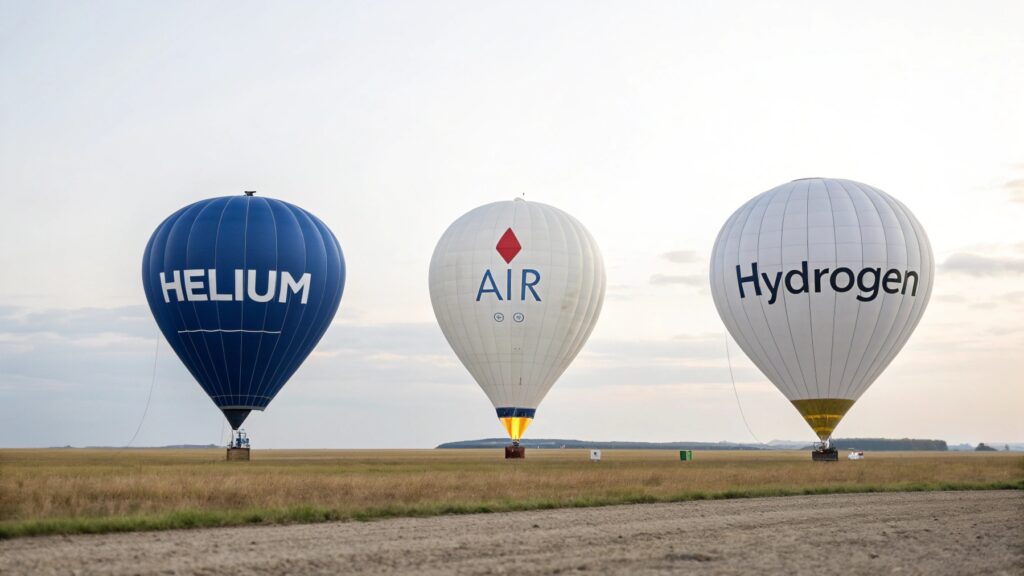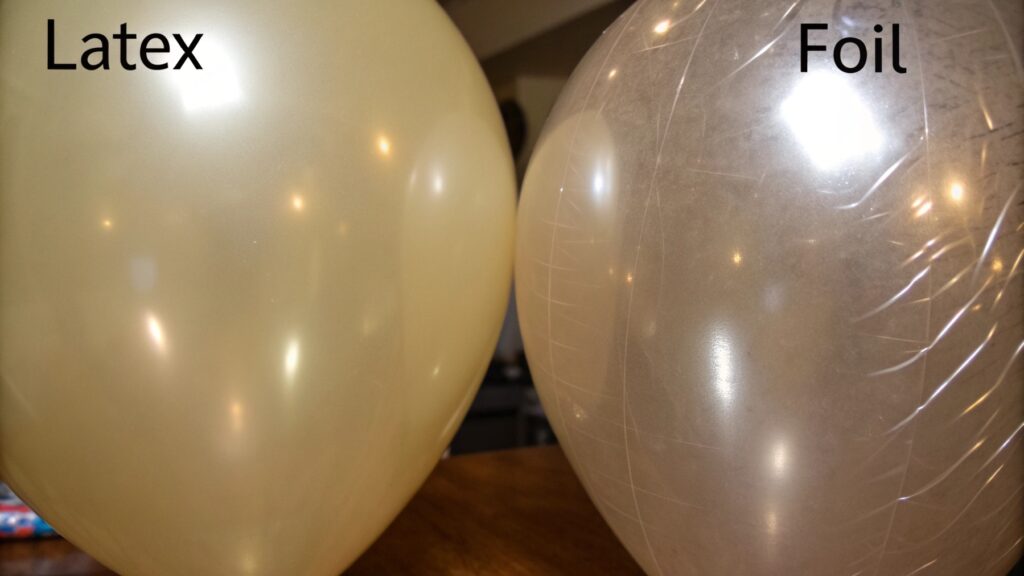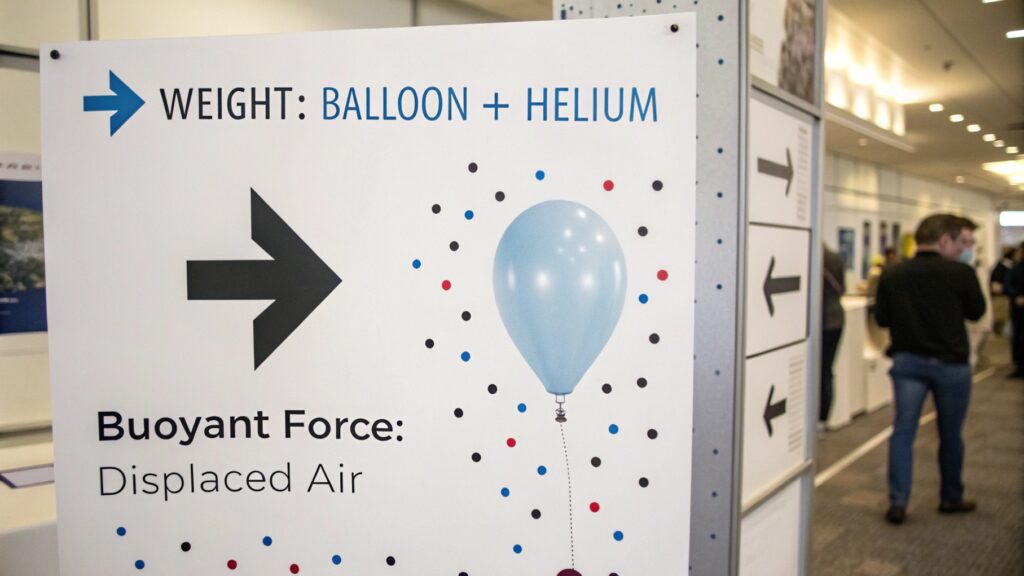What Makes Balloons Rise?
Are you struggling to understand why balloons float? Do you worry about the safety of gas in balloons? Get ready to learn the simple truth about balloon buoyancy1.
Balloons rise because the gas inside them is lighter than the air outside2. This difference in density creates an upward force called buoyancy3, which lifts the balloon.

As the Vice General Manager at AIHUA BALLOON, I've spent years understanding the ins and outs of balloon technology. I want to share this knowledge with you, so you can feel confident about the balloons you choose and use.
What causes the buoyancy in balloons?
Are you puzzled by how balloons defy gravity? Do you wonder about the forces at play? Let's break down the secret to a balloon's lift.
Buoyancy is an upward force4 exerted by a fluid that opposes the weight of an immersed object. For balloons, the fluid is air. The gas inside the balloon is less dense than the surrounding air5, creating this upward force.

Let me tell you a story. When I first started in the balloon industry, I was fascinated by how a thin piece of latex could hold enough gas to lift something. I learned that it's not the balloon material itself that lifts, but the gas inside compared to the air outside. It's like a boat floating on water; the boat displaces water, and the water pushes back up. A balloon displaces air, and the air pushes back up. This buoyant force is what makes the balloon rise. It needs to be stronger than the weight of the balloon and the gas inside.
Understanding Air Density
Air is not empty space. It's made of tiny particles, like nitrogen and oxygen. These particles have weight. The density of air is how much weight is in a certain amount of space.
- Air density6 changes with temperature and pressure.
- Warm air is less dense than cold air.
- Air at lower altitudes is denser than air at higher altitudes.
How Buoyancy Works
Think of a balloon filled with air. It falls to the ground because the air inside is the same density as the air outside. Now, think of a balloon filled with helium. Helium is much lighter than air.
- The helium balloon pushes the surrounding air out of the way.
- The weight of the air that is pushed away is greater than the weight of the balloon and the helium inside.
- This difference in weight creates the buoyant force, pushing the balloon up.
| Gas | Density (kg/m³) at 20°C | Lighter than Air? |
|---|---|---|
| Air | 1.204 | No |
| Helium | 0.164 | Yes |
| Hydrogen | 0.084 | Yes |
This table shows how much lighter helium and hydrogen are compared to air. This density difference7 is key to buoyancy.
How does the gas inside a balloon affect its ascent?
Are you wondering why some balloons float and others don't? Does the type of gas really make a difference? Let's look at how the gas inside controls the balloon's journey.
The type of gas inside a balloon directly affects whether it will rise. Gases lighter than air, like helium and hydrogen, will cause a balloon to ascend. Gases denser than air, like carbon dioxide or even just air itself, will cause a balloon to fall or stay put.

At AIHUA BALLOON, choosing the right gas for our balloons is a critical part of our process. We understand that the gas is the engine of the balloon's flight. When a customer wants a balloon to float, we know they need a gas that provides lift. If they want a balloon to sit on the ground or be used for decoration without floating, air is fine. The wrong gas means the balloon won't do what the customer expects. We always guide our clients on the best gas for their needs, keeping safety and performance in mind.
Lightweight Gases for Lift8
Two gases are commonly used to make balloons float: helium and hydrogen. Both are significantly lighter than air.
- Helium is an inert gas. This means it does not react easily with other substances. It is very safe to use in balloons because it is not flammable.
- Hydrogen is even lighter than helium. However, hydrogen is highly flammable and can explode if it comes into contact with a spark or flame.
Gas Density and Weight
The ascent of a balloon depends on the total weight of the balloon and the gas compared to the weight of the air it displaces.
- If the weight of the balloon and gas is less than the weight of the displaced air, the balloon rises.
- If the weight is greater, the balloon falls.
- If the weight is equal, the balloon stays put.
| Gas | Density (kg/m³) | Relative Lifting Power (compared to Air = 0) | Safety | Cost |
|---|---|---|---|---|
| Helium | 0.164 | High | Safe | High |
| Hydrogen | 0.084 | Very High | Danger | Low |
| Air | 1.204 | None | Safe | Free |
As you can see, while hydrogen provides more lift, its safety risk makes it unsuitable for most consumer applications. Helium, though more expensive, is the standard for floating balloons due to its safety.
Is the material of the balloon important for it to rise?
Do you think the balloon itself helps it float? Is the material as crucial as the gas inside? Let's clarify the role of the balloon's skin.
While the gas inside is the primary factor for a balloon's ascent, the material of the balloon is important. It must be lightweight and strong enough to hold the gas without leaking, but it doesn't contribute to the lifting force itself.

At AIHUA BALLOON, we know that even the best gas won't make a balloon float if the material isn't right. We work with different materials like natural rubber latex and foil. Each material has its properties. A heavier, thicker material needs more lifting gas to get off the ground. A material that leaks gas quickly means the balloon won't float for long. We focus on using materials that are strong yet light, ensuring the balloon performs as expected and holds the gas effectively. This balance is key to a quality floating balloon.
Material Weight and Strength
The material of the balloon adds weight. This weight subtracts from the total lifting power provided by the gas.
- A lighter material means less weight to lift, so the balloon can rise more easily or carry a small weight tied to it.
- The material must be strong enough to withstand the pressure of the gas inside. If it's too weak, it will pop.
Gas Permeability9
Balloons are not perfectly airtight. Gas slowly leaks out through the material over time. This is called permeability.
- Some materials are more permeable than others. Latex balloons typically lose helium faster than foil balloons.
- Higher permeability means the balloon will lose its lift and descend sooner.
| Material | Typical Use | Gas Permeability | How Long it Floats (with Helium) |
|---|---|---|---|
| Natural Latex | Party balloons | High | Hours to a day |
| Mylar/Foil | Shaped balloons | Low | Days to weeks |
| Chloroprene/Neoprene | Special applications | Very Low | Weeks to months |
Choosing the right material is about balancing cost, durability, appearance, and how long the balloon needs to float. Foil balloons cost more but float much longer than latex because their material is less permeable to helium.
What is the science behind why helium balloons float?
Are you curious about the physics that makes helium balloons go up? Is it magic, or is there a simple explanation? Let's uncover the science behind it.
Helium balloons float due to the principle of buoyancy, based on Archimedes' principle. The balloon filled with helium displaces a volume of air that weighs more than the combined weight of the balloon material and the helium inside. This weight difference creates an upward force that lifts the balloon.

Understanding the science helps us ensure our balloons at AIHUA BALLOON perform reliably. It’s not just about filling a balloon with gas; it's about knowing how much gas, what type of gas, and what material are needed to achieve the desired effect. When a client asks for a large balloon to carry a banner, we use physics calculations to determine the size and amount of helium needed. We apply these scientific principles every day to make sure our balloons live up to their purpose, whether it's a simple party decoration or a larger display.
Archimedes' Principle
This principle is key to understanding buoyancy. It states that the buoyant force on an object submerged in a fluid is equal to the weight of the fluid displaced by the object.
- For a balloon in air, the fluid is air.
- The buoyant force is the weight of the volume of air that the balloon occupies.
- If this force is greater than the total weight of the balloon (material + gas), the balloon floats up.
Density Comparison
The core reason helium balloons float is the large difference in density between helium and air.
- Air is a mix of gases, mainly nitrogen (N₂) and oxygen (O₂). The average molecular weight of air is about 29 g/mol.
- Helium (He) is an element with a molecular weight of about 4 g/mol.
- Since density is related to molecular weight (for gases at the same temperature and pressure), helium is much less dense than air.
| Gas | Average Molecular Weight (g/mol) | Density Relative to Air |
|---|---|---|
| Air | ~29 | 1.0 |
| Helium | ~4 | ~0.14 |
| Hydrogen | ~2 | ~0.07 |
Because helium is about 14% as dense as air, a volume of helium weighs much less than the same volume of air. The weight difference is the lifting force.
Forces Acting on a Balloon
Two main forces act on a balloon:
- Weight: The downward force due to gravity, acting on the mass of the balloon material and the gas inside.
- Buoyant Force: The upward force exerted by the displaced air.
A balloon rises when the buoyant force is greater than the weight. When they are equal, the balloon floats at a constant altitude (assuming no wind or other forces).
Conclusion
Balloons rise because the gas inside, like helium, is lighter than air, creating an upward buoyant force greater than the balloon's weight.
-
Understanding balloon buoyancy can enhance your knowledge of physics and everyday phenomena. Explore this link for a deeper insight! ↩
-
Discover the science behind why certain gases are lighter than air, which is crucial for understanding balloon behavior. Check it out! ↩
-
Learning about buoyancy can help you grasp fundamental physics concepts. This resource will clarify its significance and applications! ↩
-
Exploring the concept of upward force will enhance your comprehension of balloon mechanics and their behavior in the air. ↩
-
This link will clarify why density differences are key to buoyancy, helping you choose the right balloons for your needs. ↩
-
Understanding air density is crucial for grasping how buoyancy works in balloons and other objects. Explore this link for a deeper insight. ↩
-
The density difference between gases is key to buoyancy. Learn more about this principle and its applications in various fields. ↩
-
Explore this link to understand the best gases for balloon lift, ensuring you choose the right one for your needs. ↩
-
Understanding gas permeability is crucial for selecting the right balloon material, ensuring optimal float time and performance. ↩
